The geological theory of Plate Tectonics and the Associated Mineralization Process relating to the formation of ore deposits is a hugely complicated process with the myriad contributing variables such as rock and fluid compositions, temperature, pressure pH, eH, structure and time, all interacting to provide a host of different outcomes. In truth ore deposits and exploration geology is much an art as it is a science. However the basic concepts are very straightforward and you don’t need multiple degrees in geology to grasp these basics.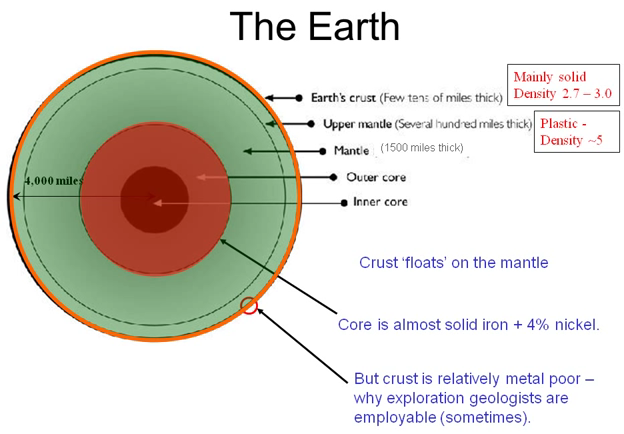
Everyone has seen diagrams of the cross section of the earth like this. The distance from the surface of the earth to the central of the core is about 4000 miles or 6400 kilometers. The deepest drill hole ever sunk reached just 12.2 kilometers below surface or ⅕ of 1% of the distance to the center of the earth. So diagrams like this are based only on indirect measurements including topography, asymmetry, observation of surface rocks, deep rock samples brought to the surface by a volcanic activity, seismic gravity and magnetic data and laboratory experiments. Based on this indirect evidence, the earth thought to consist of three main layers.
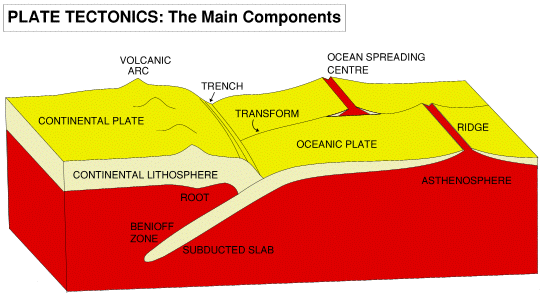
The central core is composed almost entirely of metal and nickel. The inner core is solid, the outer core is molten, the core surrounded by the mantle which is thickest of the three main layers. Although it is solid, it is hot enough to be able to flow plastically given enough time. The crust forms the outermost rind of the pipe planet and is only 5 septic kilometers thick, averaging about 30 kilometers thick. It is largely solid, although there are molten or partially molten magma chambers, for example beneath active volcanoes. The thin crust is only half the density of the mantle so the crust actually floats on top of the mantle. There’s no bumper sticker that says if it can’t be grown, it has to be mined and the vast majority of materials that are used to sustain mankind are ultimately derived from mining. And because the deepest mines on earth that’s where gold mines are only about four kilometers deep. All the minerals used by man have to be obtained from the crust. The problem is that of the three layers; core, crust and mantle, the crust is the poorest in metals.
So, let’s look at the main metal content of that crust. This table summarizes the average crustal abundance of some of the most widely used metals. Figures are expressed in parts per million.
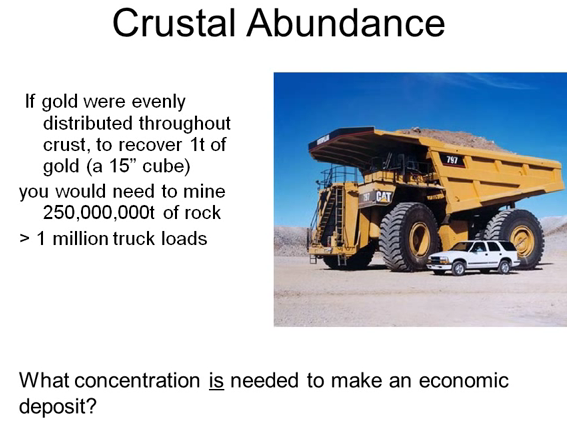
So if the crust were homogenous, each metric ton of crustal material would be just 55 grams or less than 2 ounces of copper; 12 grams of lead and a pinhead sized piece of gold. Looking at it another way to recover a 15 inch cube of gold, you would need more than one million truckloads of typical crustal rock. And I’m talking about big trucks like the one in the picture. Obviously, average crustal abundance is not going to cut it for an economic deposit. To make matters worse, if you were to try to extract these small amounts of metals, most is tied up in crystal lattice of inosilicate minerals and would be virtually impossible to recover…. even after passing accross a pulverizer.
A centrally planned Soviet Union economies we’re not particularly concerned about the cost of production. All that mattered was that there was enough volume produced to supply the state’s requirements. But the free market economy it doesn’t work that way. Metals have to be produced for less than they can be sold for, so what concentration of metal is needed to make an economic deposit?
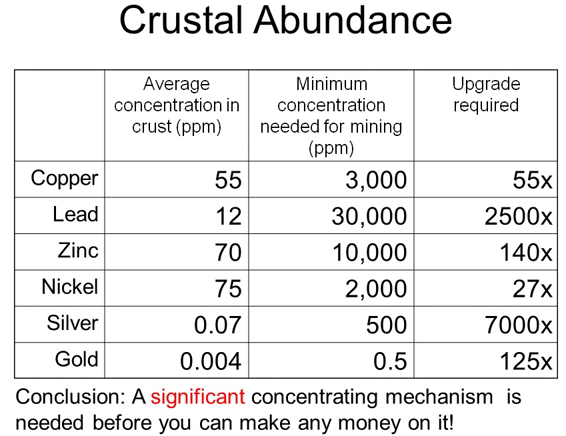
Here is some Ballpark figures, there are many factors that influence and economic cut-off, such as mining depth, sorry mining method. Depth of the deposit, continuity of mineralization, mythology and the current metal prices. However, these figures will do to illustrate my point. Few mines are profitable at a copper grade of less than 3% or 3000 parts per million. For lead, few mines operate on a lead grade of less than 3% or 30000 parts per million of lead as its whole product and so on down. So how much upgrading from crustal average does nature have to do in order to produce the material that we might want to be able to economically mine? Well looking at the right hand column, anything from 27 times in the case of nickel to 7000 times in the case of silver. The conclusion is that nature must provide a significant concentrating mechanism before we can make any money on it. It’s interesting to note that rare metals such as gold don’t necessarily require more upgrading than more commonplace metal such as lead in order to reach economic levels.
Now, let’s turn to how nature provides these high concentrations of metals ore deposits. In 90% of deposits, one single process is responsible for concentrating the metals; partially melt a section of the crust or mantle, we’ll see shortly why partially melting is important; let the magma rise through the crust and progressively cool that magma to allow certain minerals, metals to be concentrated at various of this cooling process. So melt, rise and cool and we’ll look at each of these processes in turn.
To melt rock you have to heat it or reduce the confining pressure to of an already very hard rock. There are three main ways that melting of a rock occurs in nature. Firstly by subduction; secondly by compression by piling up the rock on top of it or squeezing it horizontally; thirdly injecting hot magma into it from below. Now I’ll go through each of these in turn in the next few slides. Starting with subduction, the thin rind of the earth’s crust isn’t strong enough to withstand the convection currents in the underlying mantle, it’s broken up into a series or pieces or tectonic plates.
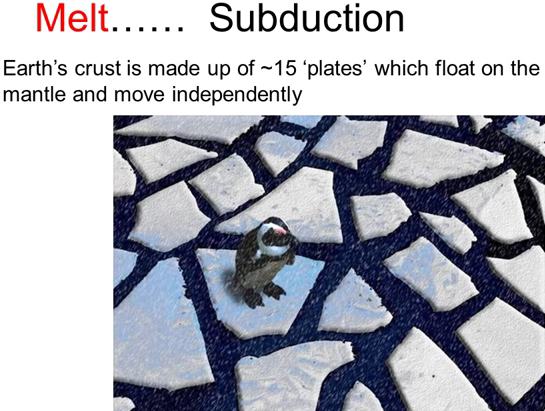
In fact they’re about 15 of these plates all being dragged in different directions and speeds but convection currents in the underlying mantle and the plates jostle one another like pack ice in the Arctic Ocean.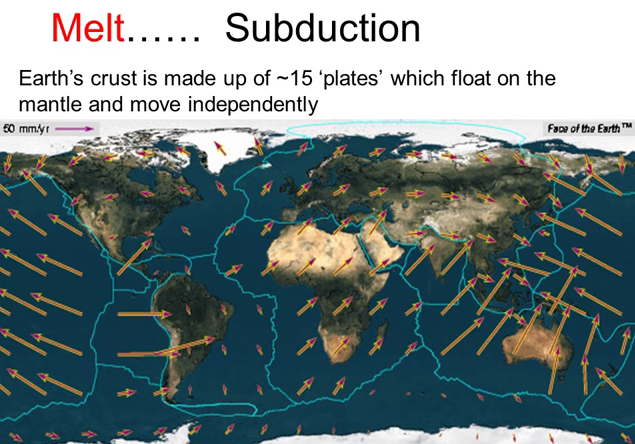
In some places they move apart, in others they override each other or simply slip past one another, in the map the red and yellow arrows show this variability in direction and speed of movement. The length of the arrows is proportional to the speed of the movement of the plate in that position. 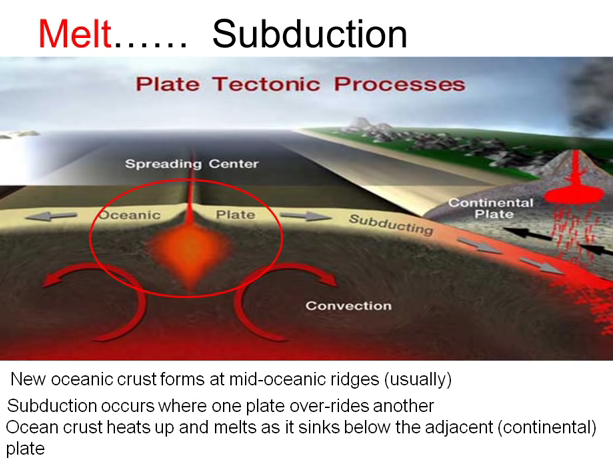
Where plates diverge, mantle material wells up along the split and new oceanic crust is formed. 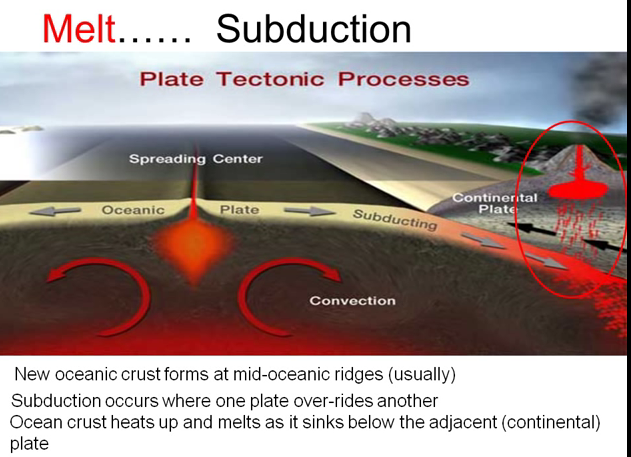
Where plates converge, one plate is subducted under the other, usually the dense oceanic plate is subducted under our listings continental plate. As it sinks into the hot mantle below the subducted plate heats up and eventually partially melts. With a lighter molten product rising up into the overlying crust to accumulated magma chambers and to form lines of volcanoes where they reach the surface.
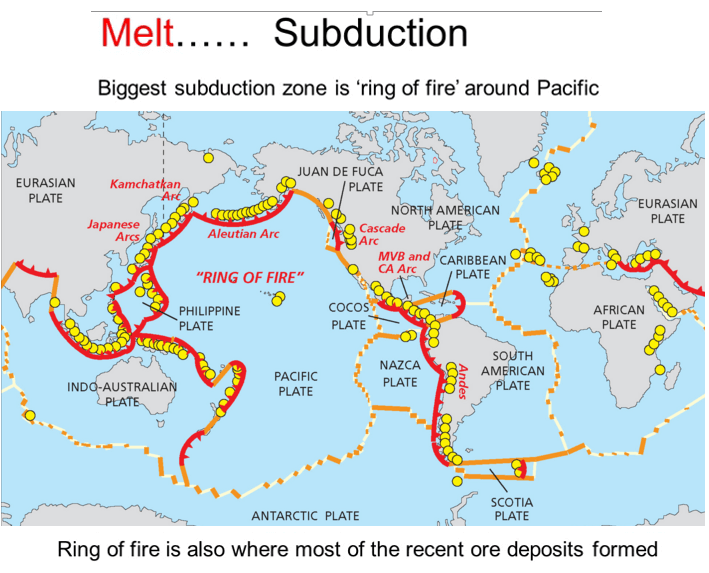 The biggest subduction zone is the so-called ring of fire around the Pacific Ocean and it’s no coincidence that the Ring of Fire is also where most of the recent ore deposits have formed. Subduction is the dominant way of getting rock to melt. However, in addition to subduction there are other ways of inducing melting. Such of thickening of the crust to increase the pressure and force the lower parts of the crust deeper into the hot mantle. There are two main ways to thicken the crust. You can pile new rocks on the surface or you can compress it horizontally to form the foals and thrust faults. This look at loading new rocks on existing crust.
The biggest subduction zone is the so-called ring of fire around the Pacific Ocean and it’s no coincidence that the Ring of Fire is also where most of the recent ore deposits have formed. Subduction is the dominant way of getting rock to melt. However, in addition to subduction there are other ways of inducing melting. Such of thickening of the crust to increase the pressure and force the lower parts of the crust deeper into the hot mantle. There are two main ways to thicken the crust. You can pile new rocks on the surface or you can compress it horizontally to form the foals and thrust faults. This look at loading new rocks on existing crust.
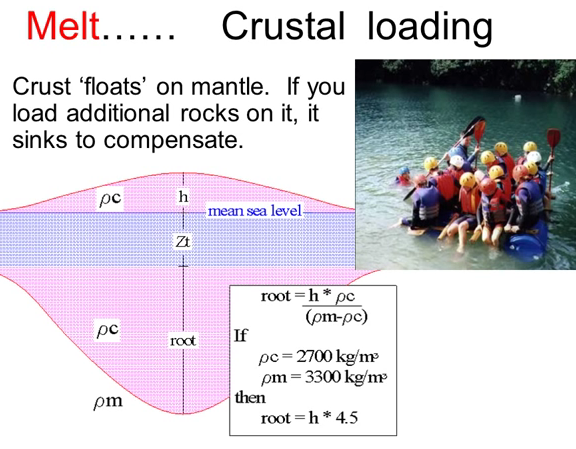
As mentioned earlier, the crust floats on the mantle like a raft or a boat on water. If you add a couple more people to a raft. It compensates for their weight by sinking a few inches and displacing more water. But because of the density difference between the crust and the air, is much greater than the density difference, the difference in density between the crust and the mantle, the base of the crust has to sink much more than the height of the now added load in order to compensate. In fact, to achieve two kilometer increase in surface elevation, you can see the H in the diagram that requires the base of the crust to sink about 9 kilometers into the mantle. That’s the distance um showed, labeled as roots in the diagram and 9 kilometers of sinking results in a temperature increase of between 250 and 300 degrees centigrade and that’s enough to start melting rocks that are already hot.
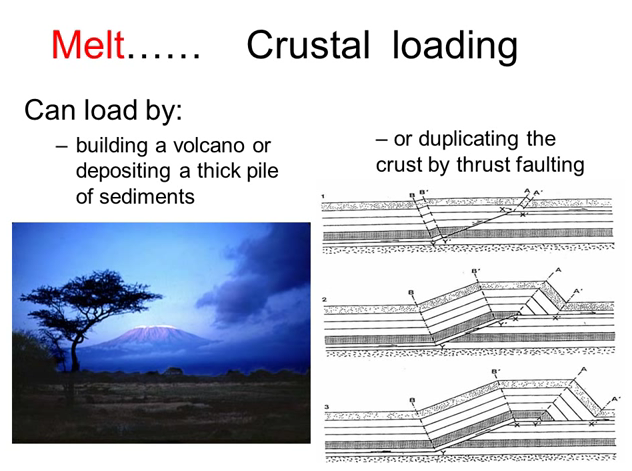
So how does this thickening of the crust happen? Well, the most common ways are either the eruption and building of a large volcanic cone such as Kilimanjaro in Tanzania which rises about 17,000 feet or 5.2 kilometers above the surrounding plains; or by depositing sediments on a continental shelf as had happened in Nevada prior to its up lift which had many kilometers of sediment lay down to it on. The second way how to thicken a crust as you can see on the diagram on the right, is to compress it horizontally; so that thrust fault form allowing one part of the crust to be pushed on top of another.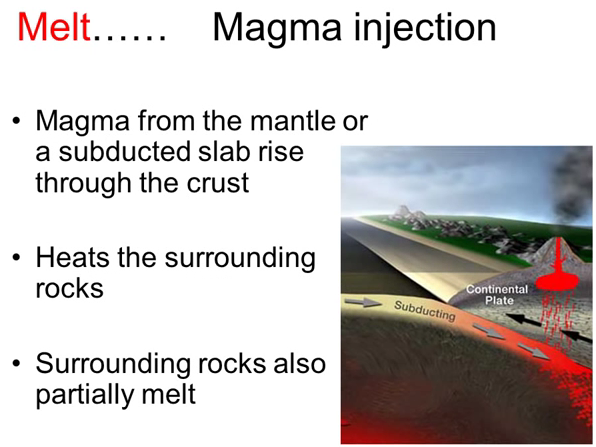
The last way to melt rocks without either subduction or thickening the crust is to inject hot magma from below. This magma injection usually occurs above a subduction zone and it’s the same principle as melting snow by pouring hot water on it.
But unlike snow which consists only of ice, rocks are usually made up of several minerals each with their own different melting point. So if you heat a rock slowly certain constituents or minerals within that rock will melt before the others. The first minerals to melt are color felsic or pale-colored and most can contain the highest percentage of silica. The remaining minerals are restite are commonly methyl or dark-colored and relatively dense. Important for us, certain metals remain in the restite and other metals prefer to separate into the felsic melt which is generally less dense in the restite.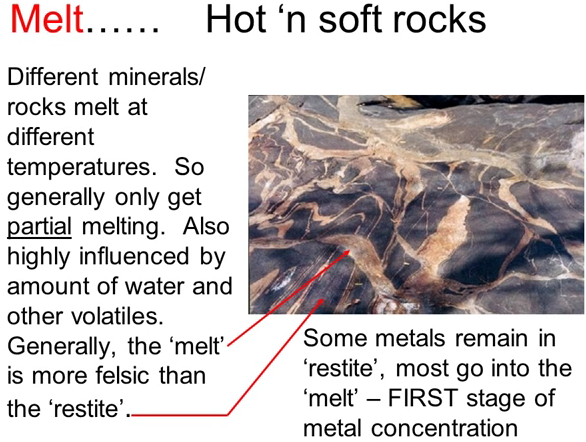
This provides a mechanism that allows the first step towards concentrating metals to potentially economic grades. Gold for example, usually partitions into the melt, so if a gold bearing rock is partially melted to produce 20% melt by volume, that melt will be enriched 5 times in gold. We can detect these areas of partial melting in the crust even though there may be tens of kilometers below the surface using seismic surveys. Seismic show them up as misty zones without any strong uh, reflectors as in this seismic section in Nevada. And notice the scale of it, maybe 80 kilometers across and the same distance top to bottom, these can be very huge volumes of rock involved. So much for the melting process.
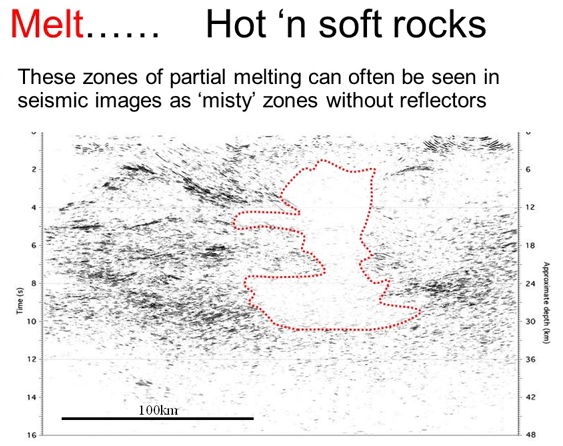
Now, let’s look at transporting this metal rich melt upwards to where it can cool and deposit metals that are potentially mineable depths. Like water dripping from a saturated sponge, the melt collects in any open spaces it can find. Because it is less dense that the surrounding restite; it starts to rise through the crust, slowly at first but increasingly rapidly as it accumulates into bigger bodies and it enters cooler rocks. Think of it as the hot wax in a lava lamp.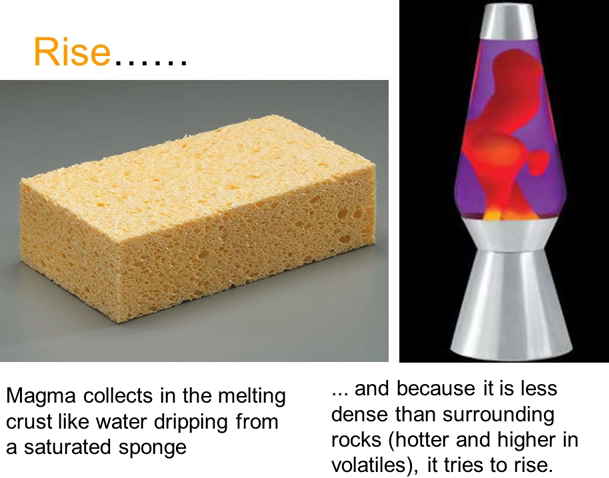
You may ask, “How can the melt rise through solid rock?” And there are three main ways that this happens. At depth where the rocks are hot and plastic. It simply displaces the rocks and passes through, shouldering the softer rocks aside and allowing them to close behind it rather like wax pushing the oil in the lava lamp.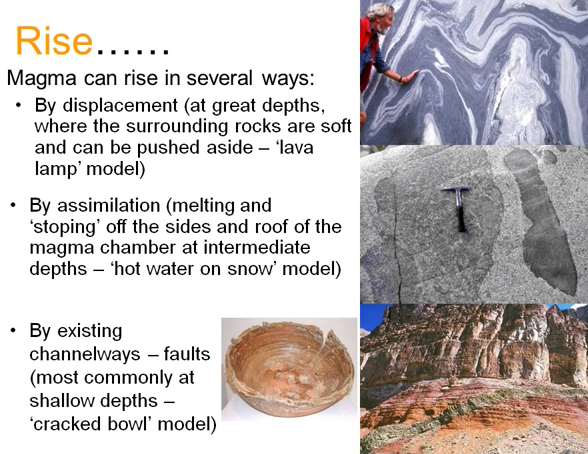
If the rocks are too brittle to allow this, it can break off the rock above it and assimilate it so it becomes part of the melt again. Rather like an ice cube floating in a beaker full of hot water. Finally near the surface where the rocks are too cold or too brittle to allow either of these methods, it relies on finding or forming fractures and then flowing up those rather like water leaking out of a crack bowl. But as the magma rises, through increasingly cool rocks it loses its own heat which in turn causes it to lose its buoyancy and it becomes more vicious. Eventually it cannot rise any further and it accumulates in a large magma chamber where it starts to crystalize. Incidentally magma chambers are often drawn as upside-down teardrop shapes like the shape on the right of the image. But in reality they usually have a flatter tabular bodies like this one that is being exposed by erosion in the Sierra Nevada.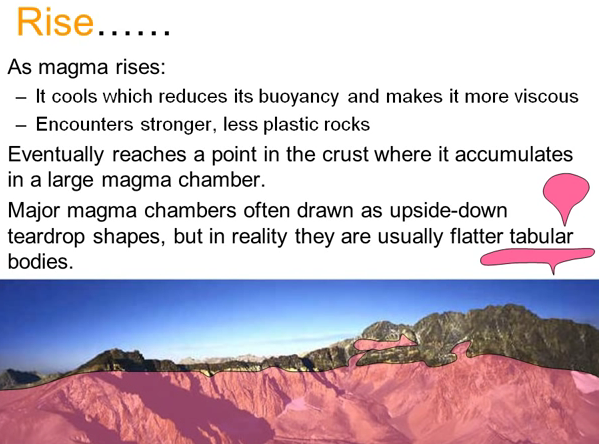
Once the magma reaches the magma chamber and stops rising, it continues to lose heat to the surrounding rocks and the magma cools.
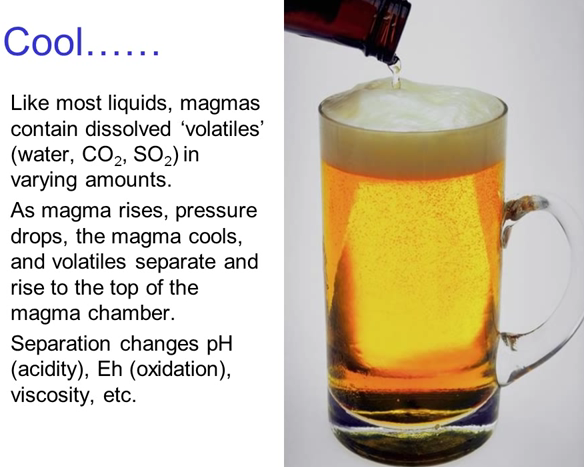
Now we come to the importance of beer in understanding ore deposits. Beer is a great analogy for cooling magmas. Like beer magmas contains varying amounts of dissolved volatiles such as water, carbon dioxide and sulfur dioxide. As magma rises, the pressure drops, the magma cools and the volatile separating rise to the top of the magma chamber just like gas bubbles in a glass of beer or a newly bottle, opened bottle of beer. The separation of the volatiles changes the pH or the acidity, the Eh or oxidation and the viscosity etc. both the gas and the remaining magma. But there isn’t just separation of volatiles and liquid magma. The magma also begins to crystalize, when an over-cool beer can is opened and the pressure suddenly drops the beer immediately starts to freeze or crystallize.
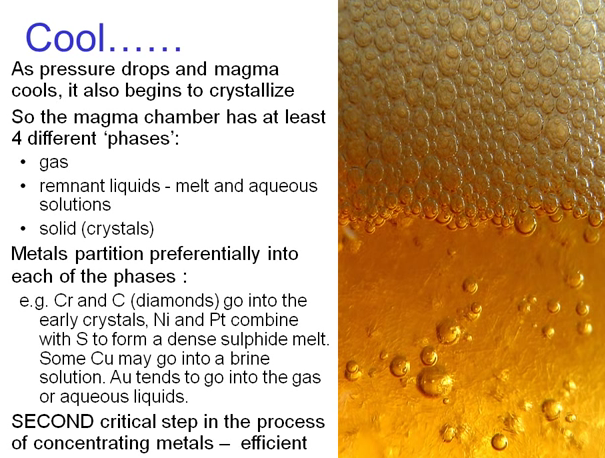
If you look closely at the picture on the right, you can see some of these crystals floating in the beer just below the foam. The same process occurs in the magma. So now our magma chamber has four different phases; volatiles, both has gas and the liquid, the main molten magma and a mush of crystallizing minerals. As occurred when the rock was originally melted, each metal preferentially partitions into one or other of these phases, in other words into the crystals the gas, the liquid or the remaining molten magma. So for example carbon in the form of diamonds and chromium in the form of chromite, partition into the early formed crystals. Nickel and platinum combined with sulfur to form a dense sulfide melts that collects at the bottom of the magma chamber like water in oil. Some of the copper may go into a brine solution and rise to the top of the chamber. Gold tends to go into the gas or aqueous liquids and also concentrate at the top of the magma chamber. So this partitioning provides the second critical process in concentrating metals to potentially economic grades.
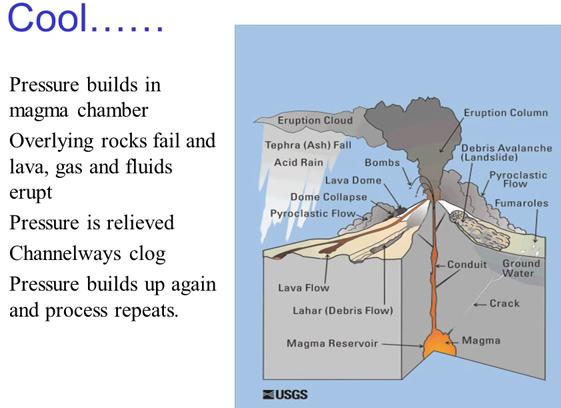
The magma chamber is usually not the end of the ride for the entire magma. It is generally, simply a collection point on its way to being erupted from the volcano as lava, steam and gas. Gas is being, is less dense than magma and so tries to occupy a larger volume. So as the magma Degases in the chamber, the pressure in the magma chamber increases. Eventually the over rocks are neither heavy enough nor strong enough to hold back that pressure and the upper portion of the magma explodes upwards and erupts at the surface. This relieves the pressure but is usually not a one-off event. It’s followed by a quiet period during which the gas and the fluids leak out as steam or hot mineral-rich water then the channel ways cloak with deposited minerals and the pressure starts to rise again and the whole process is then repeated.
Overtime metals accumulated various points in the system. Let’s look at this more closely and see how this cooling process provides a very neat way of sorting out and concentrating the metals to a potentially mineable grade. The process concentrating metals from the magma consists of cooling the magma or hydrothermal fluid so it deposits part of the material as solid crystals. These crystals are usually silicate mineral such as feldspars, pyroxenes, or quartz, which are usually of no economic value. We need to dump these waste materials in the magma chamber and then to skim off the metal rich melt or hydrothermal fluid. After this process is repeated several times the fluid becomes supersaturated and the valuable metals and they begin to drop into solution concentrated hundreds or even thousands at times to reach potentially economic grades.
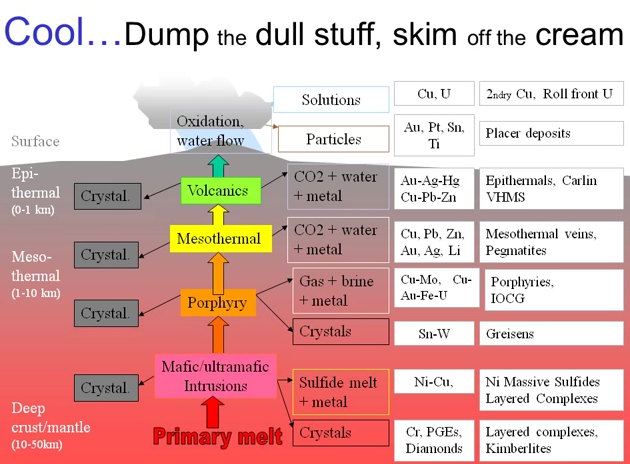
Cool, dump the dull stuff, skim off the cream. That’s the process we are going to be talking about. Geologist broadly classifies hydrothermal ore deposits according to the depth of the format. So deep crustal deposits at 10 or 50 kilometer depth, meso-thermal deposits forming between 1 and 10 kilometers depth. Epithermal deposits usually less than a kilometer and then the surface deposits right on surface. Let’s take a look at where and how these ore minerals deposits in the system. Usually some of the first to form and the first to crystallize at the greatest depth are the mafic and ultramafic intrusions and as they start to cool, they crystalize and they crystalize out minerals such as pyroxenes and olivines and maybe even some feldspars. But those contain absolutely nothing of worth in them. So the metals that we do want are concentrated either in crystals themselves that come out as a later formed crystals and for examples we could talk about chromium, platinum and diamonds forming in layered complexes and kimberlites respectively. Or maybe they would combine the sulfur to form a sulphide melt and copper and nickel are two metals that tend to do this and these intrusions. So we’ll find nickel massive sulfide deposits and we’ll find copper nickel deposits in layered complexes.
As we continue up into a shallow area we enter the porphyry domain and again as the magma continues to cool it drops our crystals this time usually of feldspars and quartz concentrating the metals that we want into the remaining, either as crystals into melt, they may crystallize out later to form thin and tungsten, Bryson. These are pretty unimportant deposits, we won’t talk too much about those but what is important with the porphyries are the metals which go into it along with the gases and these salty brines that come out of them as they cool. Predominant among these are copper and molybdenum and secondary with gold and uranium and the porphyry deposits and the IOCG’s belong to this group of deposits.
IOCG stands for iron oxide copper-gold deposits. Rising up further into the meso-thermal domain, further crystallization, at this stage. We’re normally talking most about feldspars drop out, we’re talking about quartz and carbonate minerals dropping out of there. But, again of no value to us in themselves. The metals that are of use to us concentrate further in the melt or into either the CO2 gases or the hydrothermal waters in brines that’s coming off there. Copper, lead, zinc gold, silver and lithium. Lithium’s is another odd bod like the thin and tungsten in crystallites. They form, it forms in pegmatites it’s not important and we won’t talk about it again. But copper, lead and zinc and gold in particular are very important in mesothermal veins. Most of the greenstone deposits are worldwide which are big gold suppliers are of the sort. Rising up now to the epithermal deposits, these are form right in the roots of the volcanoes or very close to surface within a kilometer of surface. This little crystallizing out useless material or material that is useless to us particularly quartz at this stage and they’re concentrating the metals that we do want either in the geothermal waters or the carbon dioxide gases.
Particularly here we’re talking about the precious metals; copper, silver and to a lesser degree mercury forming epithermal deposits and carling deposits. We do get base metals such as copper, lead and zinc forming great deposits in this environment VHMS or volcanic hosted massive sulfide deposits are very important sources of base metals. Finally when we get up to the surface and the surface rock is rained on and it start to whether getting oxygen coming in from the atmosphere and water from the rain and those react with the rock to break it down. And it can break down that rock into two forms either we can get particular form that we want, particles and that many metals are gold, platinum and titanium and these are forming placid upon deposits, washed on in streams and then concentrated by the water movement or the metals that we want are going into solution such as copper and uranium and them being deposited downstream by, in a secondary copper deposits around whether copper porphyries in particular or Uranium deposits.
Firstly, few metals are abundant enough to mine economically without being pre-concentrated by nature. Average crustal abundance is not economic and that’s something which some promoters neglect to mention. The process of melt, rise and cool is responsible for allowing 90% of deposits to reach economic grades. Partially melt by subduction, crustal thickening or injection of hot magma. Partial melting provides the first concentrating mechanism, then allow the magma to rise to mineable depths either by displacement or assimilation rocks above it or causing or taking advantage of the fractures. Then cool the magma to allow the metals to concentrate into one or another phase. And this cooling or partitioning provides the second very powerful mechanism to concentrate the metals into economic grades. Most deposit types are simply variations on the same theme with differences due to the source of the melt the depth of differentiation and the environment of deposition.
